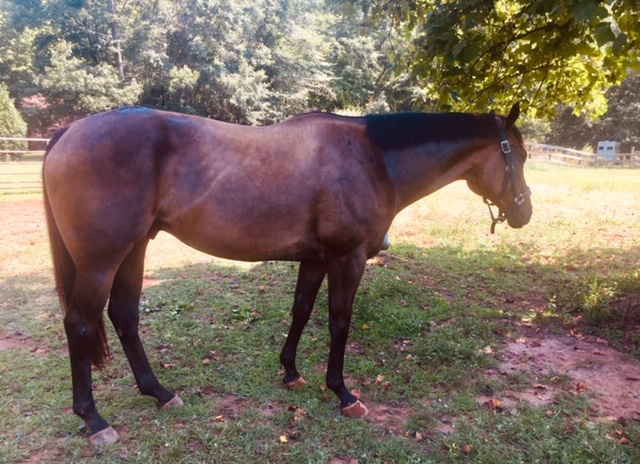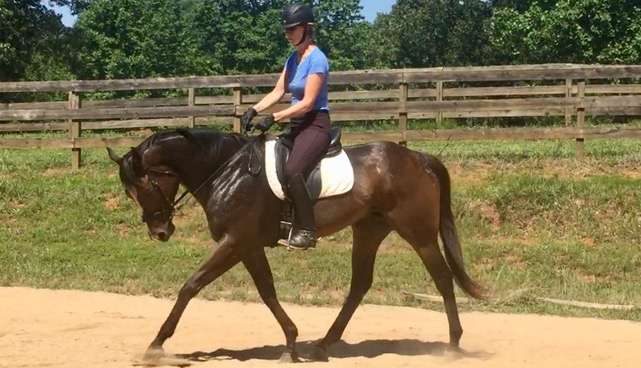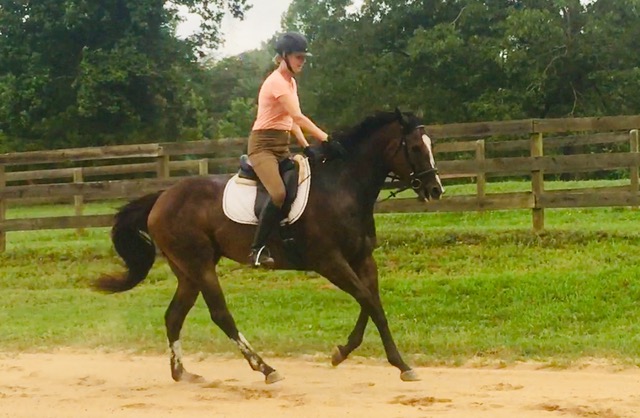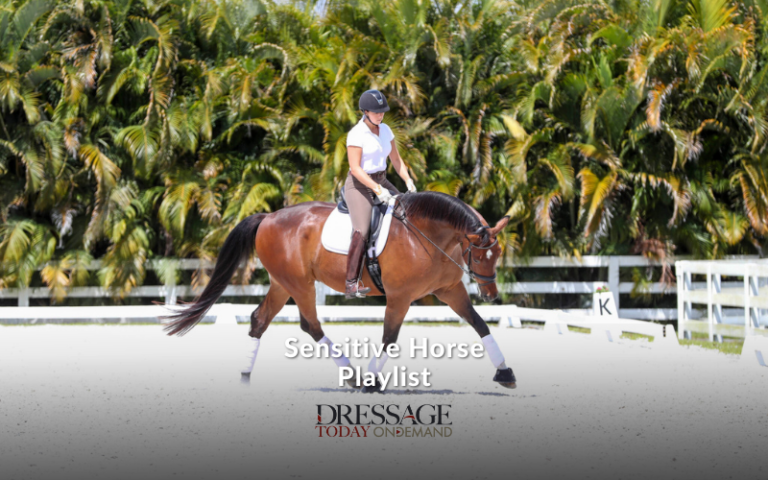I had to look twice, after Party Girl left, to make sure there weren’t any other Arab crosses hiding in my barn as there have been quite the influx of them over the last several months.
(To read more about Party Girl, click here.)
Nope, not a one. But what has arrived is a very kind, grass-green (yay, me!), 5-year-old, 17-hand OTTB named Voodoo. Perhaps not the easiest conformation for a dressage trainer with his low-set neck, and slightly bum-high build, but then he wasn’t bred for dressage, was he? He was bred to race. Unfortunately, no one asked Voodoo what it was that he might like to do and it certainly turned out not to be racing.

Voodoo’s owner, Tommy Robinson, along his wife Charlotte Cannon, are successful trainers in their own right with Charlotte winning the hunter division at the Thoroughbred Makeover, and Tommy finishing ninth out of 90 in the dressage on one of their other OTTBs.
But like any thinking rider, when you hit a road block, you look for a bit of assistance and I was quite flattered that Tommy began to bring Voodoo for lessons to address…well, everything, really. Tommy could get rather a pleasant trot out of him but the canters, especially the transitions, were rushed, unbalanced and a bit shambolic owing to souvenirs from Voodoo’s racing days: a very tense jaw, stiff back, not to mention a sacrum that was pushed forward and torqued an inch higher on the right side than the left.
Voodoo was extremely one-sided, not just from having been on the track, but because he physically wasn’t capable of moving into the left side of his body. We called in Dr. Joy Baker who gave him immediate relief with thorough chiropractic and acupuncture work. Now we could begin to actually train him with a body that worked.
The first thing I needed to address was Voodoo’s hard mouth. We all know that on the track, jockeys take a hold when they want to shift into top gear and as the horses are ridden off the hand, it’s no wonder they may end up a mass of evasions from head-flinging to tongue lolling. And if there’s been a lot of pulling and the mass of nerves that lie beneath the bars of the mouth are destroyed, they ain’t never coming back.
The problem is that if I didn’t have access to the jaw, I couldn’t get access to the poll, neck or back. So the first thing I did with Voodoo, as I did with Forrest in an earlier blog, was to introduce jaw flexions, first on the ground, and then mounted. Because at the end of the day, in order to straighten Voodoo by teaching him the diagonal aids of inside leg into outside rein, if I can’t close my outside rein and have him give in his jaw, we can’t progress any further. Lucky for me Voodoo is a kind and willing student and after a few rides he began to relax his mouth and his rigid neck and back. I don’t mind if he’s a bit behind the vertical. He’s a horse whose evasion was to invert. There will be noooo problem riding that poll up, but I can’t do that properly if he’s going around like a hammock with his hocks in Georgia.

After spending a few rides teaching Voodoo a turn on the forehand and leg yields, we began to focus on the canter. No matter how balanced I thought I had him before the depart he tended to plunge onto his right shoulder, invert and rush, which is very common in OTTBs, as crooked horses tend to be insecure horses and run away from what’s unpleasant. They don’t know they’re crooked—they just feel unsteady and uncomfortable.
On top of this he made it clear he was having racetrack flashbacks and simply didn’t trust my hand, so I said, “Cool, how about I just give you the inside rein to prove I’m not going to grab your mouth?” And I must say, I went through a bottle of Prosecco that evening after “letting go” of a tense 17-hander as he took a spin around the arena a few times. Did I mention my arena isn’t enclosed?

I knew, and Voodoo knew, his canter was going to be a work in progress and we weren’t going to nail the departs and maintain rhythm and balance in a handful of rides. But what I was been able to achieve with this youngster in a few rides was increasing trust, so that when we landed back into trot, I could continue to give with my inside rein every few strides and assure him, “See? No reason to taxi for take-off, nobody’s going to hold onto you. Just chill.”
And the toy at the bottom of the Cracker Jack box was that he began to release his back with a big sigh and swing. With a challenging project, sometimes just a moment like that can make your whole week…no Prosecco needed!











